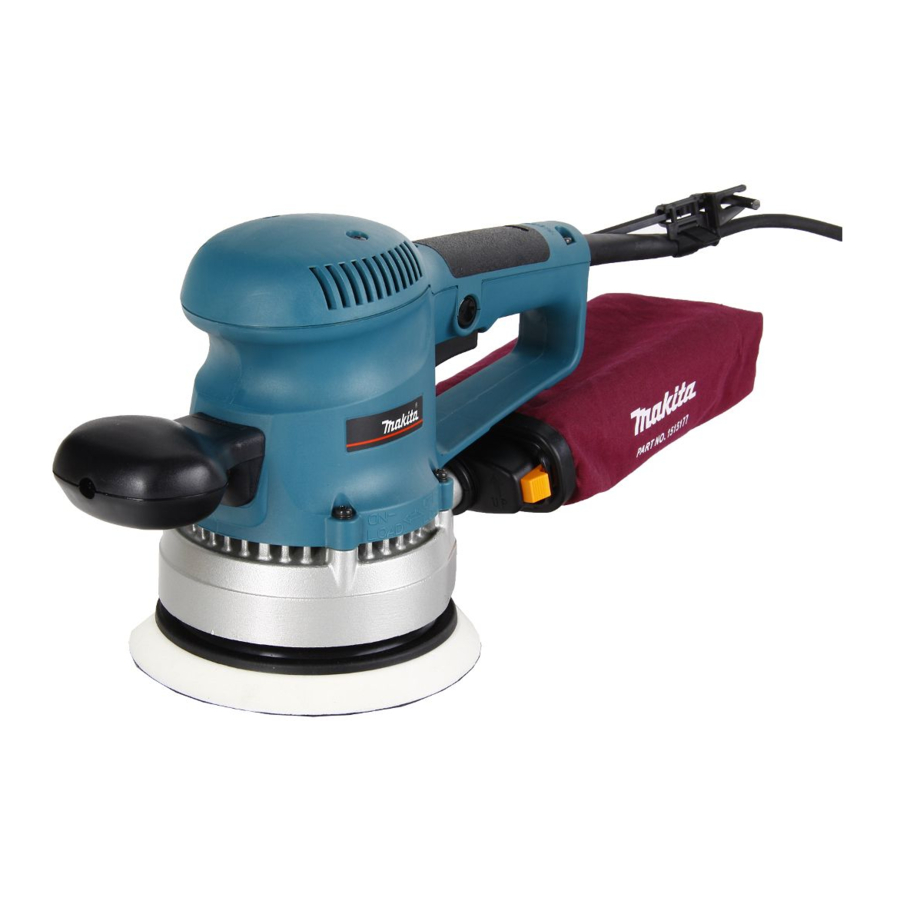Installing paper dust bag
To install the paper dust bag, place the paper dust bag on
the paper dust bag holder with its front side upward.
Insert the front fixing cardboard of the paper dust bag
into the groove of the paper dust bag holder. (Fig. 6)
Then press the upper part of the front fixing cardboard in
arrow direction to hook it onto the claws. (Fig. 7)
Insert the notch of the paper dust bag into the guide of
the paper dust bag holder. Then install the paper dust
bag holder set on the tool. (Fig. 8 & 9)
Front grip (Fig. 10)
Install the front grip on the tool so that its protrusions fit
into the matching notches in the front of the tool. Secure
the front grip using a screwdriver to tighten the screw
through the hole in the front grip.
Changing pad (Fig. 11)
Makita offers an extensive range of optional super soft
and standard equipped soft pads. Remove the screw
counterclockwise from the center of the base by a sharp
tap with a hammer on the hex wrench. After changing the
pad, tighten the screw clockwise securely.
Switch action (Fig. 12)
CAUTION:
Before plugging in the tool, always check to see that the
switch trigger actuates properly and returns to the "OFF"
position when released.
To start the tool, simply pull the trigger. Release the trig-
ger to stop. For continuous operation, pull the trigger and
then push in the lock button. To stop the tool from the
locked position, pull the trigger fully, then release it.
Speed adjusting dial (Fig. 12)
The tool speed can be infinitely adjusted between
4,000 opm and 10,000 opm by turning the speed adjust-
ing dial, which is marked 1 to 5. Higher speed is obtained
when the dial is turned in the direction of number 5; lower
speed is obtained when it is turned in the direction of
number 1. Refer to the figure below for the relationship
between the number setting on the adjusting dial and the
kind of work.
A range
A range: For polishing
B range: For finish sanding
C range: For regular sanding
NOTE:
The above figure shows standard applications. They may
differ under certain conditions.
C range
B range
Dial setting
Sanding operation (Fig. 13)
CAUTION:
• Never switch on the tool when it is in contact with the
workpiece surface, causing an injury to operator.
• Never run the tool without the abrasive disc. You may
seriously damage the pad.
• Never force the tool. Excessive pressure may decrease
the sanding efficiency, damage the abrasive disc or
shorten tool life.
Turn the tool on and wait until it attains full speed. Then
gently place the tool on the workpiece surface. Keep the
base flush with the workpiece and apply slight pressure
on the tool.
Polishing operation
CAUTION:
• Use only a Makita genuine sponge pad, felt pad or wool
pad (optional accessories).
• Always operate the tool at low speed to prevent work
surfaces from damage/burning.
• Never force the tool. Excessive pressure may decrease
the polishing efficiency and cause motor overload,
resulting in tool malfunction.
1.
Applying wax (Fig. 14)
Use an optional sponge pad. Apply wax to the
sponge pad or work surface. Run the tool to smooth
out wax.
NOTE:
First, wax a non critical portion of the work surface to
make sure that the tool will not scratch the surface or
result in uneven waxing.
2.
Removing wax (Fig. 15)
Use an optional felt pad. Run the tool to remove
wax.
3.
Polishing (Fig. 16)
Use an optional wool pad. Run the tool and apply
the wool pad gently to the work surface.
5

